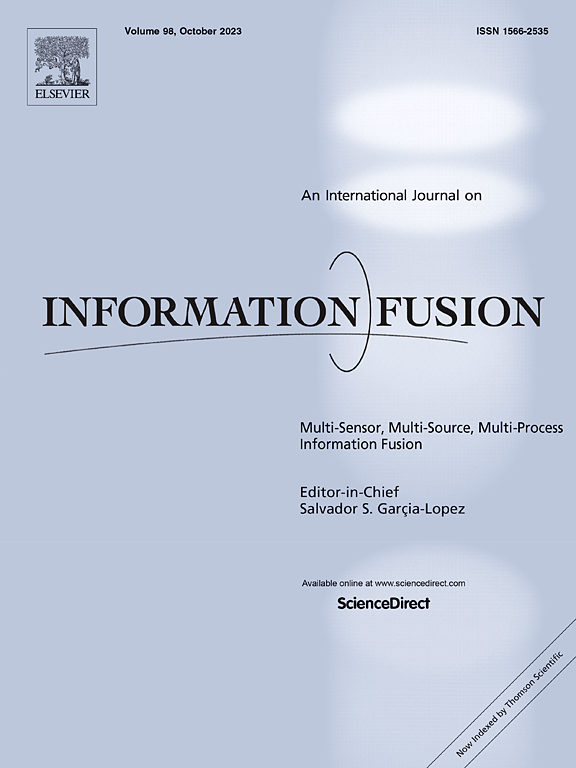Low-rank tucker decomposition for multi-view outlier detection based on meta-learning
IF 14.7
1区 计算机科学
Q1 COMPUTER SCIENCE, ARTIFICIAL INTELLIGENCE
引用次数: 0
Abstract
The analysis and mining of multi-view data have gained widespread attention, making multi-view anomaly detection a prominent research area. Despite notable advancements in the performance of existing multi-view anomaly detection methods, they still face certain limitations. (1) The existing methods fail to fully leverage the low-rank structure of multi-view data, which results in a lack of necessary interpretability when uncovering the latent relationships between views. (2) In the recovery of the consensus structure, the current methods achieve this merely through a simple aggregation process, lacking in-depth exploration and interaction between the potential structures of each view. To address these challenges, we propose the Low-Rank Tucker Decomposition based on Meta-Learning (LRTDM) for multi-view outlier detection. First, the low-rank Tucker decomposition is employed to reveal the low-rank structure of the multi-view self-expressive tensor. The factor matrices and core tensor effectively preserve and encode the latent structure of each view. This structured representation can efficiently capture the potential shared features between views, allowing for a more refined analysis of each individual view. Furthermore, meta-learning is utilized to define the learning and fusion of view-specific latent features as a nested optimization problem, which is solved alternately using a two-layer optimization scheme. Finally, anomalies are detected through the consensus matrix recovered from the latent representations and the error matrix during the self-expressive tensor learning process. Extensive experiments conducted on five publicly available datasets demonstrate the effectiveness of our approach. The results show that our algorithm improves detection accuracy by 2% to 10% compared to state-of-the-art methods.
基于元学习的多视图异常点检测的低秩tucker分解
多视图数据的分析与挖掘得到了广泛的关注,多视图异常检测已成为一个重要的研究领域。尽管现有的多视点异常检测方法在性能上取得了显著进步,但仍然存在一定的局限性。(1)现有方法未能充分利用多视图数据的低秩结构,导致在揭示视图之间潜在关系时缺乏必要的可解释性。(2)在共识结构的恢复中,目前的方法仅通过简单的聚合过程来实现,缺乏对每个视图的潜在结构之间的深入探索和交互。为了解决这些挑战,我们提出了基于元学习的低秩塔克分解(LRTDM)用于多视图异常点检测。首先,采用低秩Tucker分解揭示多视图自表达张量的低秩结构;因子矩阵和核心张量有效地保存和编码了每个视图的潜在结构。这种结构化表示可以有效地捕获视图之间潜在的共享特性,从而允许对每个单独的视图进行更精细的分析。此外,利用元学习将特定视图潜在特征的学习和融合定义为嵌套优化问题,并使用两层优化方案交替解决。最后,通过自表达张量学习过程中从潜在表征和误差矩阵中恢复的共识矩阵来检测异常。在五个公开可用的数据集上进行的大量实验证明了我们方法的有效性。结果表明,与目前最先进的方法相比,我们的算法将检测精度提高了2%至10%。
本文章由计算机程序翻译,如有差异,请以英文原文为准。
求助全文
约1分钟内获得全文
求助全文
来源期刊

Information Fusion
工程技术-计算机:理论方法
CiteScore
33.20
自引率
4.30%
发文量
161
审稿时长
7.9 months
期刊介绍:
Information Fusion serves as a central platform for showcasing advancements in multi-sensor, multi-source, multi-process information fusion, fostering collaboration among diverse disciplines driving its progress. It is the leading outlet for sharing research and development in this field, focusing on architectures, algorithms, and applications. Papers dealing with fundamental theoretical analyses as well as those demonstrating their application to real-world problems will be welcome.
 求助内容:
求助内容: 应助结果提醒方式:
应助结果提醒方式:


